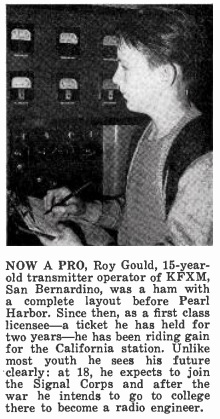 Seventy-five years ago today, the October 26, 1942, issue of Broadcasting carried this picture of the transmitter engineer of KFXM, San Bernardino, California, who appears to be dutifully taking some transmitter readings for the log.
Seventy-five years ago today, the October 26, 1942, issue of Broadcasting carried this picture of the transmitter engineer of KFXM, San Bernardino, California, who appears to be dutifully taking some transmitter readings for the log.
Because of wartime labor shortages, the engineer responsible for keeping this station on the air was a fifteen year old high school student, Roy Gould, W6UKX. (A few days ago, we saw how wartime labor shortages led a group of New York radio servicemen to train high school students to keep their shops open for the duration.)
Gould had received his ham ticket shortly before Pearl Harbor, and had managed to get on the air, with a homemade transmitter and receiver on 10 meter AM, before the war shut down amateur radio for the duration.
Since Gould also held his first class commercial license, he managed to stay on the air by getting a job at the broadcast station, which was at the time running 100 watts at 1240 kHz, sharing air time with KPPC, a Pasadena Presbyterian Church station.
According to the caption of the photo, Gould’s plans after the war were to go to college to “become a radio engineer.”
I was able to track down Mr. Gould–or I should say Professor Gould–and learn that his plans changed somewhat, although his early days in radio were clearly the inspiration for his career. I received a nice e-mail from him, and also found a 1996 Oral history interview.
In his e-mail, he writes:
Thanks for the links, I have never seen this picture.
I remember those days well. I used to operate the transmitter and on Sunday evenings, record a Mutual Don Lee network program on the big 16″ acetate covered disks for replay at a later time. There was no announcer in the studio on Sunday evenings so I even signed the station off at the end of the day. I also covered remote broadcasts of some of the big bands at the San Bernardino Civic Auditorium, setting up microphones and operating the control box during the broadcast.
I got my ham license W6UKX in early 1941, and did a little operating before WWII shut down ham radio. I let it lapse in the 1950’s when I was in graduate school. However, that call sign was never reissued, so I was able to get it back under the vanity call sign program in the 1990’s. I have a web page, w6ukx.caltech.edu, but for some reason it Is down now. I’ll look into that. [Here’s the 2015 archived version at the Wayback Machine.]
Thanks again for the great photo with the short note. 73.
Roy

Prof. Roy Gould. Caltech photo.
Gould never became a “radio engineer”. According to his biography at Caltech, he received his undergraduate degree from Caltech in 1949, with graduate degrees from Stanford and Caltech. He became Professor of Electrical Engineering and Physics at Caltech, and served a stint as the chairman of the school’s Division of Engineering and Applied Science.
According to his Wikipedia entry, he received the 1994 James Clerk Maxwell Prize for Plasmaphysics, and served as the Director of Fusion Research at the Atomic Energy Commission.
In his 1996 interview, Gould credits his early radio experience as the seed for his career. He reports that in high school, he was “not a very good student.” But his uncle’s barn was full of old radio equipment and magazines, and he “used to go up there and read these things and look at the equipment, play with it and stuff like that. I got started in electronics with crazy experiments.” Of course, we are also advocates of crazy experiments, and students seeking inspiration will find ideas, some crazier than others, in our science fair idea posts.
The shortage of broadcast engineers meant that he was able to get the job at the radio station, which he reported as being more interesting than was going on in school.
The broadcast station where Gould got his start, KFXM, doesn’t appear to be around in its original form. However, the station and call letters live on as a noncommercial low-power FM station, KFXM-LP. The old AM station appears to have been a major Top-40 outlet during the 1960’s, and when it went dark, the low power FM station was licensed to The Organization For the Preservation & Cultivation of Radio to carry on the tradition.
After letting his license lapse during grad school, Gould got his ticket after achieving emeritus status, and is again active on HF, including a number of portable DX operations detailed at his website.
